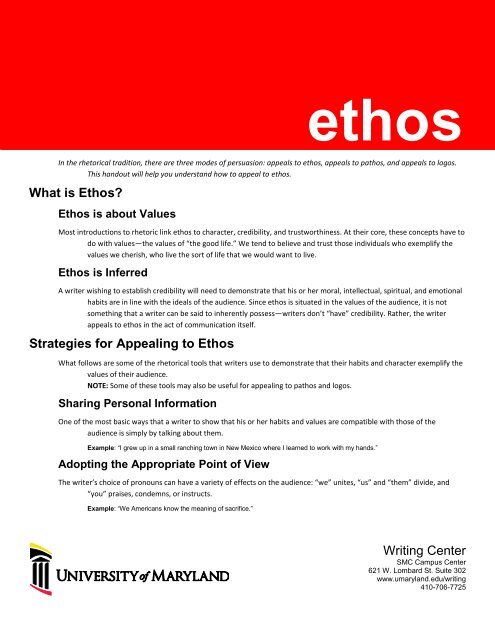Writing Center What is Ethos? Strategies for Appealing to Ethos
Writing Center What is Ethos? Strategies for Appealing to Ethos
Writing Center What is Ethos? Strategies for Appealing to Ethos
Create successful ePaper yourself
Turn your PDF publications into a flip-book with our unique Google optimized e-Paper software.
ethosIn the rhe<strong>to</strong>rical tradition, there are three modes of persuasion: appeals <strong>to</strong> ethos, appeals <strong>to</strong> pathos, and appeals <strong>to</strong> logos.Th<strong>is</strong> handout will help you understand how <strong>to</strong> appeal <strong>to</strong> ethos.<strong>What</strong> <strong>is</strong> <strong>Ethos</strong>?<strong>Ethos</strong> <strong>is</strong> about ValuesMost introductions <strong>to</strong> rhe<strong>to</strong>ric link ethos <strong>to</strong> character, credibility, and trustworthiness. At their core, these concepts have <strong>to</strong>do with values—the values of “the good life.” We tend <strong>to</strong> believe and trust those individuals who exemplify thevalues we cher<strong>is</strong>h, who live the sort of life that we would want <strong>to</strong> live.<strong>Ethos</strong> <strong>is</strong> InferredA writer w<strong>is</strong>hing <strong>to</strong> establ<strong>is</strong>h credibility will need <strong>to</strong> demonstrate that h<strong>is</strong> or her moral, intellectual, spiritual, and emotionalhabits are in line with the ideals of the audience. Since ethos <strong>is</strong> situated in the values of the audience, it <strong>is</strong> notsomething that a writer can be said <strong>to</strong> inherently possess—writers don’t “have” credibility. Rather, the writerappeals <strong>to</strong> ethos in the act of communication itself.<strong>Strategies</strong> <strong>for</strong> <strong>Appealing</strong> <strong>to</strong> <strong>Ethos</strong><strong>What</strong> follows are some of the rhe<strong>to</strong>rical <strong>to</strong>ols that writers use <strong>to</strong> demonstrate that their habits and character exemplify thevalues of their audience.NOTE: Some of these <strong>to</strong>ols may also be useful <strong>for</strong> appealing <strong>to</strong> pathos and logos.Sharing Personal In<strong>for</strong>mationOne of the most basic ways that a writer <strong>to</strong> show that h<strong>is</strong> or her habits and values are compatible with those of theaudience <strong>is</strong> simply by talking about them.Example: “I grew up in a small ranching <strong>to</strong>wn in New Mexico where I learned <strong>to</strong> work with my hands.”Adopting the Appropriate Point of ViewThe writer’s choice of pronouns can have a variety of effects on the audience: “we” unites, “us” and “them” divide, and“you” pra<strong>is</strong>es, condemns, or instructs.Example: “We Americans know the meaning of sacrifice.”<strong>Writing</strong> <strong>Center</strong>SMC Campus <strong>Center</strong>621 W. Lombard St. Suite 302www.umaryland.edu/writing410-706-7725
Incorporating SourcesQuoting or alluding <strong>to</strong> a source that the audience holds in esteem not only allows the writer <strong>to</strong> show that he or she valuesthe same authorities as the audience, but also that he or she has done h<strong>is</strong> or her “homework” on the subject.Example: “Like the Bible says, ‘An eye <strong>for</strong> an eye, and a <strong>to</strong>oth <strong>for</strong> a <strong>to</strong>oth.’”Establ<strong>is</strong>hing an Authoritative VoiceOne way <strong>for</strong> writers <strong>to</strong> sound like an expert <strong>is</strong> <strong>to</strong> use short, unqualified, declarative statements.Example: “Americans do not accept failure as an option.”Identifying With the AudienceWriters identify with their audience when they acknowledge something the audience does or believes and then claims <strong>to</strong>do the same thing.Example: “Like you, I have spent long nights worrying about my next mortgage payment or my child’s college tuition.”Giving a Balanced PresentationPresenting both sides of the argument <strong>is</strong> one way writer can show that he or she <strong>is</strong> capable of cool, level-headed thought.Most importantly, it <strong>is</strong> an attempt <strong>to</strong> demonstrate the value of fairness.Ethical FallaciesExample: “My opponent says that we need <strong>to</strong> take care of the environment. I agree with him: we need <strong>to</strong> make sure our water <strong>is</strong>clean and our air <strong>is</strong> pure. But we shouldn’t place so many barriers around the environment that we can no longer accessthe resources that we need.”Simply put, a fallacy <strong>is</strong> an argument that <strong>is</strong> more persuasive than it should be because its conclusion rests on faulty prem<strong>is</strong>esand assumptions.Irrelevant Appeal <strong>to</strong> AuthorityNo one <strong>is</strong> an expert on everything. Sometimes writers quote authorities that are either unacceptable <strong>to</strong> the audience orwho simply aren’t experts on the subject.Example:” Of course I believe that we should have a flat tax—George Lucas himself argued <strong>for</strong> the idea!”Ad Hominem (“Personal Attack”)Sometimes writers sidestep the argument and attack the person making the argument. When they do th<strong>is</strong>, they are arguing“<strong>to</strong> the man” and are making a fallacious argument.Example: “Of course she would argue <strong>for</strong> making birth control more readily available—she’s a slut!”Guilt by AssociationTh<strong>is</strong> fallacy occurs when a writer tries <strong>to</strong> link two persons or groups in order <strong>to</strong> impute the character<strong>is</strong>tics of one <strong>to</strong> theother.Example: “Do you really want <strong>to</strong> vote <strong>for</strong> a man who has been endorsed by the Hugo Chavez?”<strong>Writing</strong> <strong>Center</strong>SMC Campus <strong>Center</strong>621 W. Lombard St. Suite 302www.umaryland.edu/writing410-706-7725
Po<strong>is</strong>oning the WellTh<strong>is</strong> fallacy occurs when writers try <strong>to</strong> d<strong>is</strong>credit their opponents be<strong>for</strong>e they even have a chance <strong>to</strong> defend themselves. Itusually takes the <strong>for</strong>m of an ad hominem attack and/or a red herring.Example: “I’m going <strong>to</strong> let the congressman speak, but remember that th<strong>is</strong> <strong>is</strong> a man who has admitted <strong>to</strong> cheating on h<strong>is</strong> wife.”Tu Quoque (“You, Too”)“Tu quoque” <strong>is</strong> a Latin phrase meaning “you, <strong>to</strong>o!” Accordingly, th<strong>is</strong> fallacy describes the attempts of writers <strong>to</strong> negate apoint of critic<strong>is</strong>m by accusing the accuser of the same thing.Example: “My opponent says I am guilty of embezzling, but she <strong>is</strong> the biggest embezzler that there <strong>is</strong>!”Ad Lazarum (“Appeal <strong>to</strong> Poverty”)The “poverty argument” (Lazarus, in a New Testament parable, was a poor man), <strong>is</strong> based on the assumption that beingpoor <strong>is</strong> somehow more authentic, sincere, or genuine than being wealthy.Example: “Those African villagers have nothing and are still happy. They must be doing something right.”Ad Antiquitatem (“Appeal <strong>to</strong> Tradition”)Though an “appeal <strong>to</strong> the past” can be a useful way of arguing, making the claim that something <strong>is</strong> correct just because ithas always been that way <strong>is</strong> fallacious.Example: “Throughout h<strong>is</strong><strong>to</strong>ry, the primary responsibility of women has been the home.”Ad Crumenam (“Appeal <strong>to</strong> Wealth”)The “argument <strong>to</strong> the purse” supposes that because someone <strong>is</strong> wealthy or successful, he or she must necessarily becorrect as well.Example: “My husband has succeeded in business. I know he will make a good president.”Ad Hitlerum (“Compar<strong>is</strong>on <strong>to</strong> Hitler”)The argumentum ad hitlerum <strong>is</strong> exactly what it sounds like—making an argument by comparing something or someone <strong>to</strong>Adolf Hitler and the Naz<strong>is</strong>.ReferencesExample: “I think we’ve heard my opponent’s argument be<strong>for</strong>e—in 1940s Berlin!”Bur<strong>to</strong>n, G.O. (n.d.). Silva rhe<strong>to</strong>ricae. Retrieved from: http://rhe<strong>to</strong>ric.byu.eduHauser, G.A. (2002). Introduction <strong>to</strong> rhe<strong>to</strong>rical theory. Long Grove, IL: Waveland.Keith, W.M., & Lundberg, C.O. (2008). The essential guide <strong>to</strong> rhe<strong>to</strong>ric. Bos<strong>to</strong>n: Bed<strong>for</strong>d.McInelly, B.C., & Jackson, B. (2011).<strong>Writing</strong> and rhe<strong>to</strong>ric. Plymouth, MI: Hayden.<strong>Writing</strong> <strong>Center</strong>SMC Campus <strong>Center</strong>621 W. Lombard St. Suite 302www.umaryland.edu/writing410-706-7725
















